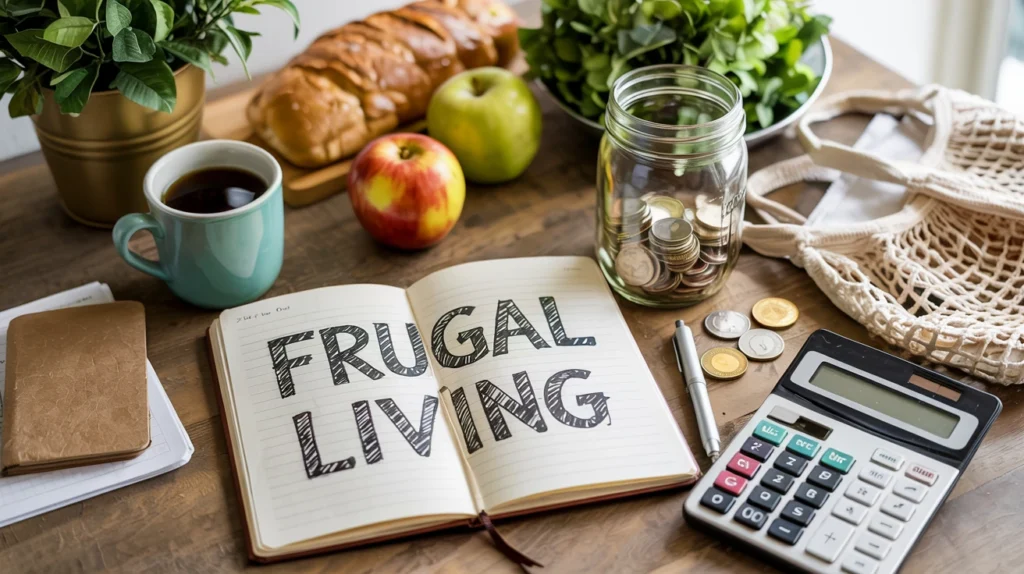Frugal Living Tips: 30 Real Strategies That Actually Work (and Don’t Make Life Miserable)

Ever feel like your paycheck disappears the second it arrives? You’re not lazy or bad with money — costs are up, and temptation is everywhere. The good news: real frugal living tips don’t require moving off-grid or cutting all joy. They’re about getting more from what you already have, keeping the fun, and ditching the waste.
Below are 30 practical, proven strategies that work in real life — for students, families, single earners, and anyone rebuilding. I’ll show you how to cut the big costs first (housing, food, utilities), plug money leaks, and build momentum with quick wins you can try today.
Mindset & Money Foundation (Start Here)

1) Audit your spending (the 7-day “open eyes” challenge)
For one week, track everything you spend in a notes app — no judging, just awareness. You’ll instantly spot “invisible” leaks: coffees, snacks, delivery fees, random subscriptions. Tag each item must / nice / no. Next week, pause all “no” items and cap “nice” items. You just created room in your budget without touching the essentials.
2) Give every dollar a job (simple zero-based plan)
List your monthly take-home income. Now assign every dollar somewhere (rent, groceries, gas, sinking funds, debt, fun) until nothing is “left floating.” This doesn’t feel restrictive — it feels clarifying. When decisions pop up, you have already decided.
RELATED READ: Zero Based Budget Complete Guide.
3) Automate two things: bills and savings
Set bills to autopay (to avoid late fees) and schedule a small transfer to savings the day you’re paid. Even $20–$50 builds the habit. Automation removes decision fatigue; you’re “paying yourself first” before the month gets noisy. (Automation and pre-commitment are frequently recommended by Bankrate and others. Bankrate)
4) Create 3 sinking funds (tiny buckets that prevent chaos)
Pick the expenses that keep derailing you — e.g., car repairs, medical co-pays, gifts/travel. Auto-save a small amount into each bucket. When the “surprise” hits, you pay cash instead of credit. Frugal living is less about deprivation and more about pre-planning.
Food & Groceries (Fast Savings Without Feeling Deprived)

5) Meal-plan around your calendar, not recipes
Open your week: which nights are busy? Plan the simplest dinners there (eggs, soups, sheet-pan meals). Batch-cook one base (rice, beans, roast chicken) and remix it. When dinner fits your schedule, you won’t panic-order takeout. (Meal planning + fewer impulse meals = lower spending, widely supported.
6) Build a “stretch base”: rice, pasta, potatoes, oats
Anchor meals with budget-friendly bases, then layer flavor (sauce, herbs, frozen veg). You’ll make smaller amounts of pricier proteins go further, and you’ll waste less. (Stretching meals is a common frugal cooking approach echoed by multiple food-budget sources.
7) Shop your pantry first (FIFO)
Before buying groceries, scan your pantry/freezer. Plan two meals using what’s already there and rotate older items to the front (“first in, first out”). You’ll instantly cut your next bill and stop throwing money in the trash. (Using what you have and tracking expiry dates are frequent frugal wins.
8) Learn unit prices and compare sizes
Ignore the front price. Check the per-ounce or per-item label and choose the best value. Be careful with bulk if you can’t finish it before it spoils. A quick glance at the unit price can save dollars weekly. (Comparing unit prices is a well-documented saver.
9) Downshift brands mindfully
Switching to store brands for staples (flour, sugar, spices, canned goods) often delivers similar quality for much less. Start with 3 items; if you don’t love one, swap back. (Generics can be comparable in quality and cheaper — reinforced by mainstream personal finance guides.
10) Eat out with rules, not guilt
Decide your max eat-out budget for the month and pre-pick two places you’re excited about. Everything else? Recreate your favourites at home (copycat recipes are everywhere). You’ll enjoy meals out more when they’re intentional.
Housing & Utilities (The Big Levers)

11) Renegotiate or reduce your rent (and move costs smartly)
If lease renewal is coming, kindly ask about loyalty discounts, longer lease for a lower rate, or free parking/storage. If you need to move, consider farther from the city center or smaller footprints (studio/one-bed) and use your savings to build emergency cash.
12) Tame utilities with “set-and-forget” tweaks
Swap to LED bulbs, unplug “vampire” chargers, use smart power strips. Set thermostats a couple degrees warmer in summer/cooler in winter and dress for the season. These tiny shifts compound into noticeable monthly drops.
13) Learn your landlord’s maintenance rhythm
Report issues early (leaks, drafts, faulty seals). A sealed window or fixed drip reduces bills and prevents bigger damage. Frugal living isn’t just cost-cutting — it’s cost-prevention.
Transportation (Own Your Commute)

14) Build a “cheapest route” habit
For routine routes, try the fuel-saver setting on maps, compare toll vs. no-toll, and batch errands in a single loop. Keep tires inflated and combine cold-start trips. If transit or carpool works even twice a week, the savings are real.
15) Downshift the car (if it’s draining you)
If the payment and insurance are crushing, price out selling or trading down to a reliable used model. The monthly cash flow relief often outweighs the pride of a newer car — and frees funds for debt payoff or emergency savings.
Shopping, Subscriptions & Stuff

16) Delete “buy now” triggers
Remove stored cards from browsers, log out of shopping apps, and unsubscribe from promo emails. You’ve just created a speed bump between impulse and purchase — which is often enough to skip it. (Reducing spending cues is a common best practice in frugal lists.
17) Use a 72-hour list
When you want something non-essential, put it on a notes-app list for 72 hours. If you still want it (and it fits your budget), buy it. Most cravings pass — and you’ll be amazed how many “needs” vanish.
18) Run a 30-day “no-buy” theme
Pick a category (clothes, décor, gadgets) and do a 30-day freeze. Keep a tally of what you didn’t buy — that number is motivating. You’ll reset habits and teach your brain that waiting is normal.
19) Cancel and consolidate subscriptions
Open your app store/PayPal/bank and list every recurring charge. Cancel anything you haven’t used in 30 days. For keepers, switch to annual or family plans and share where allowed. (Subscription audits and consolidation are staple tips in Bankrate’s savings guides. Bankrate)
20) Buy second hand first
Search secondhand apps or local buy-nothing groups before purchasing new. Furniture, kids’ clothes, kitchen gear, even workout equipment can be found at a fraction of retail — or free. Set alerts for brands/sizes you buy often.
Income, Debt & Big-Picture Wins
21) Make the “other side” of the budget bigger
Frugality isn’t only about cutting; it’s also about earning. Pick a simple side stream aligned with your skills (freelance tasks, tutoring, marketplace reselling, digital templates). Dedicate that extra income to one goal (emergency fund or fastest debt). Momentum = motivation.
22) Refinance or snowball debt (fastest first)
List debts from smallest balance to largest. Pay minimums on all, then attack the smallest with every spare dollar until it’s gone. Repeat. Each payoff gives a psychological win that keeps you going.
23) Review insurance and providers annually
Shop around for car/home/renters insurance and cell/internet after your contract term. New-customer promos change constantly. Ten minutes of comparison shopping can save hundreds over a year. (Comparing recurring services appears in many credible money-saving lists.
Health, Family & Everyday Life

24) Build a “use-it-up” station
Designate a shelf/bin for open products: half-used shampoo, sauces, snacks, candles. Finish them before buying replacements. It’s oddly satisfying — and it keeps money in your pocket. (This “use it up first” idea shows up consistently in frugal roundups.)
25) Swap childcare, pet-sitting, or tutoring with trusted friends
Create a simple rotation: one family watches kids Saturday morning; the other takes Sunday afternoon. Barter your strengths (math help for piano help). Trading time beats paying cash.
26) Use discount programs you already qualify for
Check student, educator, military, healthcare, or employer perks. Many include app discounts, museum/free-day access, or lower pricing on software and subscriptions you already use.
Tech, Tools & Tiny Habits That Save Big
27) Track unit prices with a running list
Make a tiny spreadsheet or notes page called “Best Price Log” for common purchases (rice, detergent, cat litter). Note the product, size, unit price, and store. When you see a better unit price, stock up (within reason). This one habit quietly saves you all year. (Comparing per-unit cost is a core, research-backed saver.
28) Split bulk with a friend
Want the warehouse deal but not the waste? Team up. Divide large packs of meat, paper goods, and pantry staples. You both get the low unit price without storage headaches.
29) Create a 10-minute weekly money meeting
Every Sunday, do three micro-tasks: check your balances, move any “extra” to savings/debt, and plan the week’s quick dinners. Ten minutes prevents $100 mistakes.
30) Celebrate free
Make a list of zero-cost fun: library passes, park hikes, free museum days, community events, DIY movie nights. When fun is easy and free, you don’t default to expensive “boredom spending.”
RETALED: How to Budget Irregular Income.






